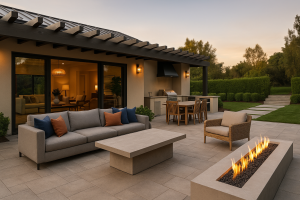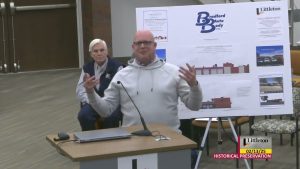Building an apartment complex can be a complex process that involves several stages, including development, planning, financing, and construction. In this guide, we outline the 10 steps to build an apartment complex, providing a comprehensive overview of the entire process, from start to finish. Whether you’re an experienced developer or new to the industry, this guide will provide valuable insights and tips for making your project a success.
Throughout the guide, we will discuss key considerations for each stage of the process, including conducting a market analysis, securing financing, selecting a suitable site, developing a comprehensive plan, obtaining permits and approvals, hiring a construction team, choosing construction materials, overseeing the construction process, marketing and leasing the apartments, and addressing some commonly asked questions related to the 10 Steps to Build an Apartment Complex. We will also provide a timeline for each stage of the process, so you can stay on track and ensure your project is completed on time and within budget.
Conduct a Market Analysis
Before embarking on building an apartment complex, it is crucial to conduct a thorough market analysis. This analysis will help investors determine the viability of the project and the potential demand for rental properties in the area.
The first step in conducting a market analysis is to research the local area, including the demographics, housing market trends, and the economic climate. This information can be gathered from local government statistics, real estate reports, and other reliable data sources.
| Factors to Consider | Description |
|---|---|
| Local Demand | Evaluate the demand for rental properties in the area and identify any potential gaps in the market |
| Demographic Trends | Consider factors such as the age, income, and lifestyle of potential tenants |
| Competing Properties | Research similar properties in the area and determine their rental rates, vacancy rates, and amenities offered |
Once the market analysis is complete, investors can use the information gathered to make informed decisions about the apartment complex development. This includes determining the unit mix, rental rates, and amenities that will appeal to the target market.
Secure Financing
Financing an apartment complex development can be a daunting task, but there are several options available to developers. It is important to consider the pros and cons of each option and choose the best fit for your project.
| Financing Option | Advantages | Disadvantages |
|---|---|---|
| Traditional Loans |
|
|
| Public-Private Partnerships |
|
|
| Crowdfunding |
|
|
To increase the chances of securing financing, it is important to have a solid business plan that includes a detailed budget, timeline, and market analysis. You should also have a clear understanding of the potential risks and rewards of the project and be able to articulate them to potential lenders or investors.
Select a Site and Conduct Due Diligence
Choosing the right site for your apartment complex is crucial to the success of the project. Here are the key factors you need to consider when selecting a site:
- Zoning laws: Ensure that the site is zoned for multi-family housing, and that the zoning allows for the size and type of apartment complex you plan to build.
- Environmental regulations: Consider any environmental regulations that may impact the site. For example, wetlands or floodplains may restrict development in certain areas.
- Access to amenities: Look for a site that is conveniently located near shopping, dining, entertainment, and transportation options. Tenants will appreciate the convenience and accessibility of these resources.
- Demographics: Evaluate the demographics of the area to ensure the site is located in an area where there is demand for rental properties.
- Competition: Research other apartment complexes in the area and assess the level of competition. Evaluate the types of amenities and services offered by competing complexes to identify any gaps in the market that you can fill.
- Infrastructure: Consider the availability of infrastructure such as water, electricity, and sewage. Ensure that the site has adequate utility service to support your project.
Once you have identified a potential site, it’s important to conduct due diligence to ensure that the site is suitable for development. Here are some key steps to follow:
- Survey the site: Conduct a survey of the site to determine its boundaries, topography, and any potential challenges such as soil instability or water drainage issues.
- Perform soil tests: Soil tests will help identify any potential environmental hazards or concerns, such as contaminated soil.
- Review existing permits: Research the site to determine if any previous permits or approvals have been granted for development. This can help identify any potential issues or concerns that may need to be addressed.
- Obtain permits: Ensure that all necessary permits and approvals are obtained before proceeding with the project. This may include building permits, environmental permits, and occupancy permits.
Conclusion
Selecting the right site for your apartment complex and conducting thorough due diligence can help ensure that your project is successful. By considering the factors outlined in this section and following the steps for due diligence, you can minimize risks and set yourself up for success.
Develop a Comprehensive Plan
Developing a comprehensive plan is a crucial stage for building an apartment complex. It involves considering various aspects such as design, layout, and amenities that can attract potential residents.
Design
The design of the apartment complex should be in line with the overall vision of the project. It is essential to work with an experienced architect to create a design that is both functional and aesthetically pleasing. The design should consider factors such as accessibility, safety, and traffic flow.
Layout
The layout of the apartments is a critical factor in ensuring that residents feel comfortable and at home. It is important to consider factors such as the number of bedrooms and bathrooms, the size of the living area, and the kitchen layout. A well-designed layout can increase the value of the property and attract potential residents.
Amenities
Amenities are one of the key factors that influence the decision-making process of potential residents. It is important to provide amenities that cater to the needs of the target market. Common amenities include swimming pools, fitness centers, laundry facilities, and recreational areas. It is important to work with a professional to determine the appropriate amenities for the project and budget accordingly.
| Key Considerations for Developing a Comprehensive Plan | Guidelines |
|---|---|
| Market Demand | Consider the market demand for the type of apartments you are building and design the units accordingly. |
| Competition | Research the competition in the area and ensure that your apartment complex stands out by offering unique amenities and features. |
| Budget | Develop a budget for the project and ensure that the comprehensive plan aligns with this budget. |
Developing a comprehensive plan is a critical stage in building an apartment complex. It is important to work with experienced professionals to ensure that the design, layout, and amenities align with the vision for the project and the needs of potential residents.
Select a Site and Conduct Due Diligence
Before jumping in to build an apartment complex, it’s crucial to select a suitable site and conduct due diligence. Here’s what you need to know:
Factors to Consider When Choosing a Site
When choosing a site for the complex, you should consider the following:
| Factor | Considerations |
|---|---|
| Zoning Laws | Are you allowed to build an apartment complex on this site? |
| Environmental Regulations | Is the site suitable for construction? Are there any potential environmental hazards? |
| Access to Amenities | Is the site conveniently located near public transportation, grocery stores, and other amenities that renters desire? |
The Due Diligence Process
Once you’ve selected a site, it’s time to conduct due diligence. This involves:
- Researching the property’s history and ownership
- Running a title search to ensure the property is free of any liens or encumbrances
- Assessing the property’s value and potential for development
- Reviewing any existing surveys, site plans, or zoning records
It’s important to thoroughly examine the site to avoid any surprises or setbacks during the construction process. By taking the time to research and assess the property, you can ensure that your project is set up for success.
Hire a Construction Team
Once the planning and permit phase is complete, it’s time to hire a construction team. The right team can bring your vision to life and ensure the successful completion of your apartment complex project. Here are the key roles and responsibilities of the team members you’ll need:
| Role | Responsibility |
|---|---|
| General Contractor | Responsible for overseeing the entire construction process, managing subcontractors, and ensuring the project is delivered on time and within budget. |
| Architect | Responsible for designing the apartment complex, including the layout, exterior, and interior finishes. |
| Project Manager | Responsible for coordinating the construction team, managing timelines and budgets, and ensuring the project meets quality standards. |
| Subcontractors | Responsible for specific tasks such as plumbing, electrical, and HVAC installation. |
When selecting a construction team, consider their experience, references, and reputation in the industry. Make sure the team is licensed, insured, and bonded, and that they have the necessary certifications for the project.
Tips for Hiring the Best Construction Team
- Research multiple contractors before making a decision.
- Ask for references and check them thoroughly.
- Review the contractor’s portfolio and past projects.
- Consider their communication skills and responsiveness.
- Make sure their bid is comprehensive and includes all necessary tasks.
Choose Construction Materials
Choosing the right construction materials for your apartment complex is crucial for the success of the project. Not only do you need materials that are durable and cost-effective, but you also need to consider their energy efficiency and environmental impact. Here are some key factors to consider when selecting construction materials:
| Factor | Considerations |
|---|---|
| Durability | Choose materials that can withstand the wear and tear of daily use, as well as extreme weather conditions. Consider the lifespan of the product and its ability to resist damage from moisture, pests, and other factors. |
| Cost-effectiveness | While it can be tempting to cut costs by choosing cheaper materials, it’s important to balance cost with quality. Cheaper materials may require more maintenance and repairs in the long run, which can add up to higher costs over time. Consider the overall cost-effectiveness of the material before making a decision. |
| Energy efficiency | Choose materials that can help reduce energy consumption and lower utility costs for your tenants. Consider materials such as insulation, windows, and roofing that can improve the building’s energy efficiency. |
| Environmental impact | Choose materials that are sustainable and environmentally friendly. Look for products that are made from recycled materials, have low carbon footprints, and are certified by reputable organizations such as the Forest Stewardship Council. |
By considering these factors, you can make informed decisions about the best construction materials for your apartment complex. Remember to balance cost with quality and prioritize durability, energy efficiency, and sustainability.
Oversee the Construction Process
Overseeing the construction process of an apartment complex requires careful planning and execution to ensure that the project is completed on time and within budget. Here are some key tasks involved in overseeing the construction process:
- Schedule management: One of the most critical aspects of overseeing the construction process is managing the project schedule. This involves creating a detailed timeline of activities, allocating resources, and monitoring progress to ensure that the project stays on track.
- Budget management: Another crucial aspect of overseeing the construction process is managing the project budget. This involves tracking expenses, identifying cost-saving opportunities, and making adjustments as needed to ensure that the project stays within budget.
- Quality control: Ensuring that the construction is of high quality is also essential. This involves monitoring the work of contractors and subcontractors to ensure that they are meeting the project specifications and industry standards.
- Risk management: Managing risks and potential issues is also crucial during the construction process. This involves identifying potential risks and developing contingency plans in case of unexpected events.
- Communication: Effective communication with all stakeholders is essential during the construction process. This includes regular meetings with the construction team, updates to the project schedule and budget, and addressing any concerns or issues as they arise.
By effectively managing these tasks, developers can ensure that their apartment complex is completed on time, within budget, and to a high standard of quality.
Market and Lease the Apartments
Marketing and leasing the apartments is the final step in the apartment complex construction process. To ensure a successful outcome, developers need to focus on key factors like rental rates, marketing strategies, and lease agreements.
Once the complex is complete, developers need to determine rental rates that are competitive with other properties in the area. Conducting a market analysis can help determine the right price point for the target market. Developers should also consider offering move-in specials or other incentives to attract renters.
Developing a marketing strategy is crucial to make the complex stand out in a crowded market. This can include creating an online presence, using social media platforms, and leveraging local networks. Developers should also consider working with real estate agents who specialize in apartment rentals to help market the property.
Another important consideration is the lease agreement. Developers need to ensure the lease protects their interests as well as their tenants. The lease should include details on rental rates, security deposits, move-in and move-out procedures, and rules for the use of common areas.
By paying attention to these important elements, developers can maximize occupancy and rental income, making their apartment complex a profitable investment.
FAQ
Are there any financing options for apartment complex development other than traditional loans?
Yes, there are several alternatives to traditional loans for financing apartment complex development. Public-private partnerships, crowdfunding, and tax credits are just a few examples of non-traditional financing options. Each option has its own advantages and disadvantages, so it’s important to carefully consider what will work best for your specific project.
How long does it typically take to build an apartment complex?
The construction timeline for an apartment complex can vary widely depending on a number of factors, such as the size and complexity of the project, the availability of labor and materials, and the weather. However, on average, it can take anywhere from 12 to 24 months to complete an apartment complex from start to finish.
What permits and approvals are required for apartment complex development?
The permits and approvals required for apartment complex development will vary depending on where the project is located and the specific regulations in that area. However, some common permits and approvals include building permits, environmental permits, and occupancy permits. It’s important to research the requirements for your specific project and ensure that all necessary permits and approvals are obtained before construction begins.
Can I use recycled materials in the construction of my apartment complex?
Yes, incorporating recycled materials into the construction of an apartment complex is an eco-friendly and cost-effective option. Recycled materials can include everything from reclaimed wood and metal to glass and plastic. However, it’s important to carefully weigh the advantages and disadvantages of using recycled materials, as they may not be suitable for all aspects of your project.
How can I ensure that my apartment complex stands out in the market?
There are several ways to make your apartment complex stand out in the market, such as offering unique amenities, creating an attractive and functional design, and marketing effectively to your target audience. It’s important to research the competition in your area and identify areas where you can differentiate your project from others in the market.










